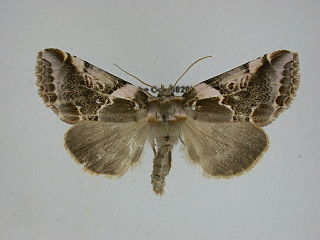
Cucurbita pepo is a cultivated plant of the genus Cucurbita. It yields varieties of winter squash and pumpkin, but the most widespread varieties belong to the subspecies Cucurbita pepo subsp. pepo, called summer squash.

The buff arches is a moth of the family Drepanidae. The species was first described by Johann Siegfried Hufnagel in 1766. It is found throughout Europe and is well distributed in the British Isles except the far north of England and all of Scotland. They live in deciduous and coniferous forests with large populations of their foodplants, but also in gardens and parks.

The Thyatirinae, or false owlet moths, are a subfamily of the moth family Drepanidae with about 200 species described. Until recently, most classifications treated this group as a separate family called Thyatiridae.

Habrosyne scripta, the lettered habrosyne or scribe, is a moth of the family Drepanidae. It was first described by Philip Henry Gosse in 1840. It is found in southern Canada and the northern United States, from Labrador to Vancouver Island, south in the Appalachians, Ozarks and Rocky Mountains to North Carolina and Mississippi and south in the west to Arizona.

Habrosyne is a genus of moths belonging to the family Drepanidae. It was first described by Jacob Hübner in 1816.
Cucurbita fraterna, also known as Cucurbita pepo subsp. fraterna, is a mesophyte plant species of the genus Cucurbita. It is native to Tamaulipas and Nuevo León, Mexico. It has not been domesticated. It is the progenitor and nearest relative of the domesticated species Cucurbita pepo and wild C. pepo is still found in the same areas as C. fraterna. It was formally described by Liberty Hyde Bailey in 1943, in Gentes Herbarum.
Habrosyne plagiosa is a moth in the family Drepanidae first described by Frederic Moore in 1882. It is found in Sikkim, India.
Habrosyne sanguinea is a moth in the family Drepanidae first described by Frederic Moore in 1882. It is found in Sikkim in India, Tibet in China and Nepal.
Habrosyne albipuncta is a moth in the family Drepanidae. It is found in Taiwan, China, Vietnam, Thailand and Myanmar.
Habrosyne aurorina is a moth in the family Drepanidae. It is found in Japan and Korea.
Habrosyne costalis is a moth in the family Drepanidae. It is found in the Philippines (Luzon).
Habrosyne dentata is a moth in the family Drepanidae. It is found in China.

Habrosyne dieckmanni is a moth in the family Drepanidae. It is found in the Russian Far East, Japan, north-eastern China and Korea.

Habrosyne gloriosa, the glorious habrosyne moth, is a moth in the family Drepanidae. It is found in North America, where it has been recorded from the northern United States, south in the Rocky Mountains to Arizona. In Canada, it is found in Ontario and Quebec.
Habrosyne intermedia is a moth in the family Drepanidae. It is found in the Russian Far East, the Korean Peninsula, Japan, India, Nepal and China.
Habrosyne obscura is a moth in the family Drepanidae. It is found in Indonesia (Java).
Habrosyne sumatrana is a moth in the family Drepanidae. It is found in Indonesia (Sumatra).
Habrosyne violacea is a moth in the family Drepanidae. It is found in the Russian Far East, Korea, China, Myanmar, Vietnam, Nepal and Sikkim, India.
Ulysses Flores Ferreras is a Filipino botanist, working as Research Associate at Philippine Native Plants Conservation Society

Diastella fraterna, commonly known as the palmiet silkypuff, is a plant of the family Proteaceae native to South Africa.








